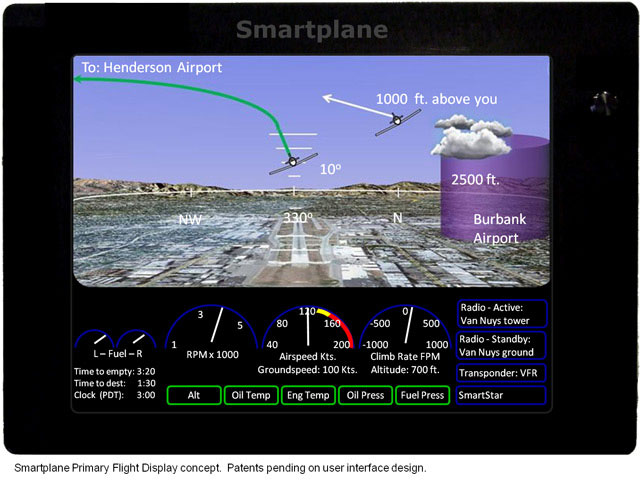 Image provided by Smartplane.
Image provided by Smartplane.
A driver can hop in almost any car in the world and instantly understand the instrumentation and controls. The same cannot be said for airplanes, particularly those equipped with glass panels, but a California software engineer and pilot hopes to change that.
Stéphane Fymat founded Smartplane Inc. with the goal of making aviation simpler, and he’s busy writing code to match his flight display concept with available avionics.
“All the information the pilot needs, and only the information the pilot needs, should be fused and assembled,” Fymat said. He hopes to begin laboratory testing soon, followed by installation and flight testing in a standard light sport aircraft (LSA).
The software Fymat is developing also would automate various navigation tasks, both before and during a flight. If the wind changes (and that data is made available through Automatic Dependent Surveillance-Broadcast, for example), the software will adjust the route to maintain maximum efficiency, accounting for airspace, turbulence, and other considerations. That would leave the pilot free to focus on what’s most important--flying the airplane--and still well-informed about what’s ahead.
Fymat said existing glass panel technology can overwhelm a user with information, much of it extraneous to the moment. The most important information can get lost in a sea of data, particularly for pilots who don’t fly frequently and must devote considerable effort to train and stay proficient in a glass panel environment.
“That’s exactly the issue,” Fymat said. “A well-designed user interface should have the opposite effect on you.”
Fymat hopes to do for avionics what Apple has done for computers: make the interface simple, intuitive, and sensitive to context.
Fymat also hopes to make navigating an aircraft as simple for the user as driving a car. In the automotive world, a GPS needs only the destination in order to calculate the best route given user-supplied criteria such as avoidance of toll roads. In many cases, the automotive GPS can take current traffic information into account, routing the driver around delays. Fymat plans to develop the same kind of functionality for the cockpit, allowing a pilot to enter a destination airport and then sit back and watch a plan take shape that accounts for current conditions. Electronic flight planning products already on the market can assist the pilot in choosing the most efficient route based on current winds, but Fymat plans to take that a step further, enabling the software to account for—and avoid—turbulence, and alert the pilot (and passengers) when to expect a few bumps if they can’t be avoided. Fymat expects that will enhance the pilot’s sense of control, and sense of safety, and make small aircraft more appealing to nonpilot passengers as well.
“If you keep people out of turbulence, that really addresses a lot of the issues I think,” said Fymat, no fan of turbulence himself.
Once the prototype is refined in the laboratory, Fymat plans to install the software in an LSA equipped with off-the-shelf avionics. The system would eventually be sold as a complete aircraft, branded under Smartplane’s name, though the aircraft itself would be manufactured by an established firm (to be named later).
Eventually, the software could be integrated with an autopilot, further reducing cockpit workload. It’s theoretically possible to fully automate the piloting task from start to finish, though Fymat has no such ambition in the near term.
“It’s not for the reasons of technology. It’s for the reasons of psychology,” Fymat said. “People need to feel a sense of control in order to not be afraid.”
Instead, he envisions a progressive approach, gradually increasing cockpit automation and giving users time to develop trust in the systems.



